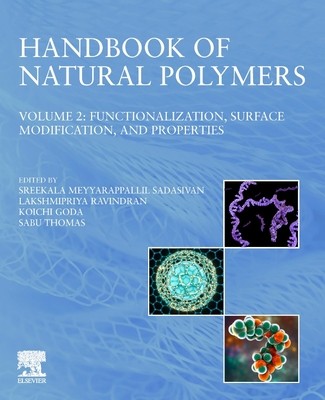
- We will send in 10–14 business days.
- Publisher: Elsevier
- ISBN-10: 0323998569
- ISBN-13: 9780323998567
- Format: 19.1 x 23.5 x 3 cm, softcover
- Language: English
- SAVE -10% with code: EXTRA
Handbook of Natural Polymers, Volume 2 (e-book) (used book) | bookbook.eu
Reviews
Description
The Handbook of Natural Polymers, Volume 2: Functionalization, Surface Modification, and Properties is a comprehensive resource covering modifications, functionalization, analysis, and properties of polymers from natural sources, with an emphasis on the latest advances.
The book begins by introducing the current state-of-the-art, challenges, and opportunities in natural polymers. This is followed by detailed coverage of methods for chemical, physical, and surface modifications, and functionalization, of natural polymers, including nanocellulose composites, gluten, chitin, alginate, pectin, keratin, shellac, wool, hemicellulose, lignin, natural rubber, albumin, collagen, gelatin, zein, soya protein, silk fibroin, gutta percha, and gum. The final chapters explain several other key aspects, such as microscopical and spectroscopical analysis, mechanical, thermal, and electrical properties, surface analysis, rheological and shape memory properties, and environmental impact of chemically modified natural polymers. The book aims to offer potential avenues for the preparation, modification, and implementation of advanced natural polymer-based materials with the desired properties for specific applications.
As part of a 3-volume handbook offering comprehensive coverage of natural polymers, this book will be of interest to all those looking to gain a broad knowledge of natural polymers, including academic researchers, scientists, advanced students, engineers, and R&D professionals from a range of disciplines and industries.
EXTRA 10 % discount with code: EXTRA
The promotion ends in 16d.13:07:53
The discount code is valid when purchasing from 10 €. Discounts do not stack.
- Publisher: Elsevier
- ISBN-10: 0323998569
- ISBN-13: 9780323998567
- Format: 19.1 x 23.5 x 3 cm, softcover
- Language: English English
The Handbook of Natural Polymers, Volume 2: Functionalization, Surface Modification, and Properties is a comprehensive resource covering modifications, functionalization, analysis, and properties of polymers from natural sources, with an emphasis on the latest advances.
The book begins by introducing the current state-of-the-art, challenges, and opportunities in natural polymers. This is followed by detailed coverage of methods for chemical, physical, and surface modifications, and functionalization, of natural polymers, including nanocellulose composites, gluten, chitin, alginate, pectin, keratin, shellac, wool, hemicellulose, lignin, natural rubber, albumin, collagen, gelatin, zein, soya protein, silk fibroin, gutta percha, and gum. The final chapters explain several other key aspects, such as microscopical and spectroscopical analysis, mechanical, thermal, and electrical properties, surface analysis, rheological and shape memory properties, and environmental impact of chemically modified natural polymers. The book aims to offer potential avenues for the preparation, modification, and implementation of advanced natural polymer-based materials with the desired properties for specific applications.
As part of a 3-volume handbook offering comprehensive coverage of natural polymers, this book will be of interest to all those looking to gain a broad knowledge of natural polymers, including academic researchers, scientists, advanced students, engineers, and R&D professionals from a range of disciplines and industries.


Reviews